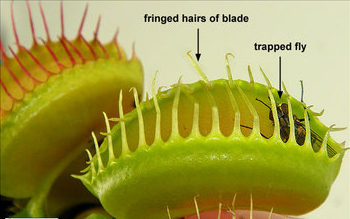Plant movements do exist. Plant use movements as an adaptation to escape or minimize injury from harmful external factors or move towards scarce resource or otherwise secure food. For example, the primary root moves downward where it can obtain water and mineral nutrients from deep down while the shoot moves upward to be exposed to light from the sun.
Other examples of plant movements include:
- Certain flowers close at night to prevent chilling injury.
- Closing and opening of stomata as a mechanism to regulate photosynthesis and transpiration under various environmental conditions.
- Carnivorous plants exhibit movement to trap insects which are to become sources of nutrition.
What are tropic movements? Tropic movements are movements of curvature that respond to the direction of the external stimuli such as light or water. Plants may either show a positive or negative movement as a response to a stimulus. If the movement is away from the stimuli, it is referred to as negative tropism and if the movement is towards the direction of stimuli, it is referred to as positive tropism. Different types of tropic movements include:
- Phototropism
- Gravitropism
- Chemotropism
- Thigmotropism
- Hydrotropism
- Thermotriopism

What are Nastic Movements? Nastic movements are plant movements that occur in response to environmental stimuli but unlike tropic movements, the direction of the response is not dependent on the direction of stimulus. Some examples of Nastic movements include the closing of the carnivorous Venus flytrap leaf when it captures prey or the folding of the mimosa leaf when it is disturbed. Different types of nastic movements include:
- Nyctinasty
- Seismonasty
- Thermonasty
- Photonasty
- Thigmonasty

Also Read: Difference Between Photoperiodism And Phototropism
Tropic Movements Vs. Nastic Movements In Tabular Form
| BASIS OF COMPARISION | TROPIC MOVEMENTS | NASTIC MOVEMENTS |
| Description | Tropic movement is a directional movement displayed by a plant as a response to an external stimulus. | Nastic movement is a non-directional response displayed by plants to external stimuli. External stimuli may include: temperature, light, change in ion concentration or change in turgor pressure. |
| Nature | In tropism, the effect is more or less permanent. | Most Nastic movements are temporary and reversible. |
| Nature Of Stimuli | Stimuli for the tropic movements are unidirectional and never diffuse. | The stimuli for the Nastic movements may be unidirection or diffuse. |
| Types | Types of Tropic Movements include: Geotropism Phototropism Thigmotropism Chemotropism Hydrotropism Thermotropism Gravitropism | Types of Nastic movements include: Epinasty Hyponasty Photonasty Nyctinasty Chemonasty Hydronasty Thermonasty Geonasty Thigmonasty |
| Rate of Movement | Tropic movements are relatively slow movements. | Nastic movements are relatively quick movements. |
| Occurrence | Tropic movements are common in plant organs with radial symmetry such as root and stem. | Nastic movements are shown by plant organs with bilateral symmetry (Flat) such as leaves and stomata). |
| Specialization in Function and Distribution | Tropic movements are less specialized in function and distribution than tropic movements. | Nastic movements are more specialized in function and distribution than tropic movements. |
| Response To Stimuli | In tropic movements, there is directional growth of a plant or part of a plant, in response to an external stimulus such as gravity or light and therefore, the direction of the stimulus controls the orientation of growth. | The direction of a Nastic movement is independent of where the stimulus comes from. It is only the quality and not the direction of the stimulus that trigger a response. |
| Where They Are Found | Tropic movements are found in all plants. | Nastic movements are mostly found in specialized plants and organ. |
| Stimulus | In tropic movements stimulus controls the orientation of the growth. | In Nastic movements stimulus triggers response. |
| Underlying Cause | Tropic movements are caused by the cell divisions in the organ. | The Nastic movements are caused by the change in the turgor pressure of the cells in the organ. |
| Examples | Movement of shoot towards the sunlight (phototropic movement). | Drooping of the leaves of mimosa pudica due to touch (Thigmonastic Movement). |
Also Read: Difference Between Phototropism And Vernalization